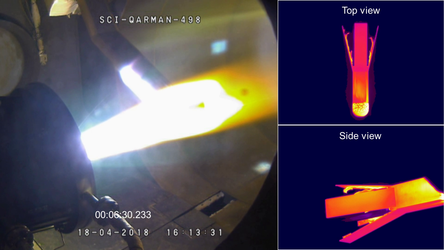

Qarman CubeSat in Hertz test chamber
This full-size prototype of part of the first CubeSat designed for atmospheric reentry is dwarfed by the cavernous surroundings of ESA’s Hertz radio-testing chamber.
CubeSats are low-cost nanosatellites based around standard 10 cm units and typically end their spaceflights burning up in the atmosphere as their orbits gradually decay. But the three-unit Qarman (QubeSat for Aerothermodynamic Research and Measurements on Ablation) is designed with this fiery fate in mind.
Designed for ESA by Belgium’s Von Karman Institute, Qarman will use internal temperature, pressure and brightness sensors to gather precious data on the extreme conditions of reentry as its leading edges are enveloped in scorching plasma.
“This CubeSat will return its results to experimenters using the Iridium commercial comsat network,” explains Roger Walker, coordinating ESA’s technology CubeSats.
“We have come to Hertz to test the hindmost element of the satellite, intended to do just that. We need to ensure that the silicon carbide panels adjacent to Qarman’s antennas will not interfere with its transmission to any Iridium satellites within view.”
Qarman’s blunt-nosed front contains most of its sensors, protected by a cork-based heatshield. The CubeSat is expected to survive its reentry, although not its subsequent fall to Earth – making it imperative that its results make it back.
ESA’s Hertz chamber, in its ESTEC technical centre in the Netherlands, is short for Hybrid European RF antenna Test Zone.
The isolated metal-walled chamber, lined with pyramid-shaped radio-absorbing foam to reproduce the endless reaches of space, offers versatile ways of measuring a subject’s radio-frequency performance.
Qarman is planned to be launched from the International Space Station during 2016 as part of the European Commission-backed QB50 flight.





